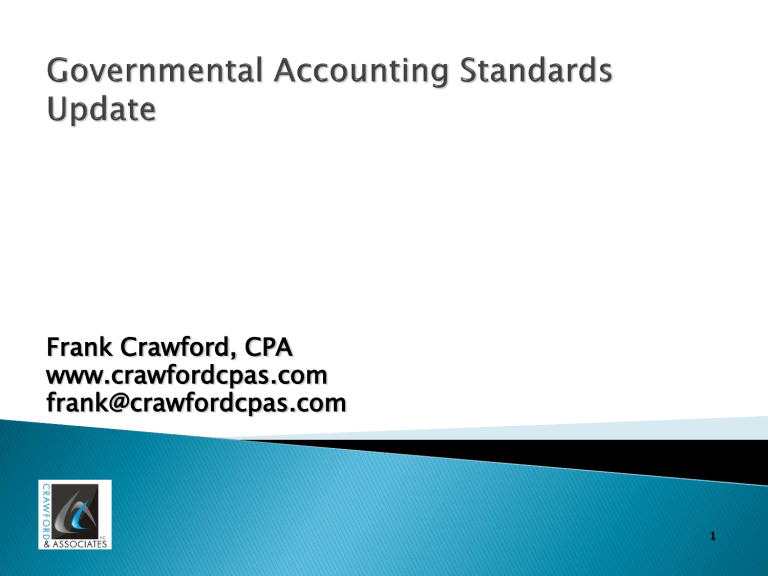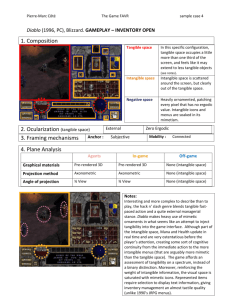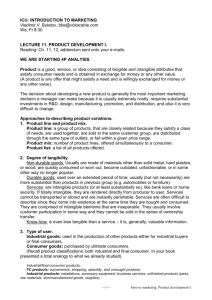Accounting and Auditing Issues Affecting Oklahoma

Frank Crawford, CPA www.crawfordcpas.com
frank@crawfordcpas.com
1
2
Statement No. 43, Financial Reporting for
Postemployment Benefit Plans Other Than
Pension Plans— April
Statement No. 45, Accounting and Financial
Reporting by Employers for Postemployment
Benefits Other Than Pension Plans— June
3
Statement No. 49, Accounting and Financial
Reporting for Pollution Remediation
Obligations —November
4
Statement No.50,
Statement No. 51,
Pension Disclosures -—May
Accounting and Financial
Reporting for Intangible Assets —June
Statement No. 52, Land and Other Real Estate
Held as Investments by Endowments
5
Statement No. 53, Accounting and Financial
Reporting for Derivative Instruments— June
Technical Bulletin No. 2008-1, Determining the Annual Required Contribution Adjustment for Postemployment Benefits
6
Statement No. 54, Fund Balance and
Governmental Fund Type Definitions —
February
Statement No. 55,
The Hierarchy of Generally
Accepted Accounting Principles for State and
Local Governments April
Statement No. 56,
Codification of Accounting and Financial Reporting Guidance Contained in the AICPA Statements on Auditing Standards –
April
7
Immediate
◦ Statement 55
◦ Statement 56
June 30, 2009
◦ Statement 45—Phase 2
◦ Statement 43—Phase 3
◦ Statement 49
◦ Statement 52
◦ TB 2008-1 (Generally)
June 30, 2010
◦ Statement 45—Phase 3
◦ Statement 51
◦ Statement 53
June 30, 2011
◦ Statement 54
Subject: accounting and reporting by employers for their OPEB expenses and obligations
Applies to all employers that provide OPEB (that is, the employer pays all or part of the cost of the benefits, including implicit rate subsidies)
Requires accrual-basis accounting for expense and measurement and disclosure of funded status (UAAL)
Subject: reporting on stewardship of plan assets by
A trustee or plan administrator
(stand-alone plan reporting) or
An employer or plan sponsor with a fiduciary responsibility for the plan assets that includes the plan as a trust or agency fund in its own financial report
“Postemployment benefits”—benefits provided after separation from employment as part of the total compensation for services, including:
◦
Pension benefits —
Retirement income
Other benefits (except postemployment healthcare) if provided through a defined benefit pension plan
◦
Other postemployment benefits (OPEB) —
Postemployment healthcare benefits
Other forms (for example, life insurance) if provided separately from a defined benefit pension plan
In Statement 45 (employer reporting):
◦ “Plan” usually refers to an employer’s substantive commitment or agreement to provide OPEB
— including, for example, provisions or understandings regarding plan membership, eligibility for benefits, types of benefits, points at which benefits will begin and end, and method of financing benefits
In Statement 43 (plan reporting):
◦ “Plan” usually refers to a trust or agency fund used to administer the financing of OPEB and the payment of benefits (that is, to assets under the stewardship of an administering entity) —regardless of the financing policy adopted
Benefits should be projected based on the current substantive plan
(the plan as understood by the employer and plan members), including changes made and communicated to plan members, at the time of the actuarial valuation and (or including) the historical pattern of sharing of costs between employer and plan members to that point
◦
Anticipated future changes in plan design should not be included in the projection of benefits
A legal or contractual benefit cap (as distinguished from a cap on contributions), should be considered in the projection of benefits if the cap is deemed effective
Postemployment benefits (pensions and OPEB) are part of the compensation for services rendered by employees; they are part of an exchange transaction between employer and employees
Benefits are “earned,” and obligations accrue or accumulate, during employment, but benefits are not taken until after employment
(potentially long time lag between incurring and paying the obligation)
The (accrual-basis) cost of benefits for a period is part of the total cost of government services for that period, whether or not the employer chooses to fund it concurrently
Harmonizes accounting requirements with funding concepts and methods to the maximum extent appropriate for accrual accounting purposes
Although OPEB plans generally are not funded, this approach still is
“funding friendly” for OPEB, because an employer that chooses to fund
(now or later) need not use different measures for accounting and funding purposes
Statement 45 does not include any requirement with respect to an employer’s method of financing or budgeting of OPEB; for example, it does not require that an employer fund the benefits using the actuarial methods required for accounting purposes
Project cash outflows for benefits
Discount projected benefits to present value (PV)
Allocate the PV of projected benefits to periods using an acceptable actuarial cost method
Employee Age Timeline
Service Period
25 40 62
Age when hired
Assumed age at retirement
Present age
Life Expectancy
80
25
$4,500
40
Actuarial Present Value
1) Project Benefits
$15,000
. . .
$14,000
62
2) Discount 80
3) Actuarial cost method
Employers also will be required to disclose the funded status of the benefits as of the most recent valuation and to present as RSI multi-year trend information about funding progress, including the following information:
◦
Actuarial accrued liability (AAL)
◦
Actuarial value of plan assets
◦
Unfunded actuarial accrued liability (UAAL) (AAL minus plan assets)
◦
Funded ratio (actuarial value of plan assets/AAL)
◦
Ratio of UAAL to covered payroll
◦
Notes to RSI regarding changes affecting the interpretation of trends in the amounts reported
An employer’s commitment to permit retirees to participate in the same group as active employees by paying the blended premium involves a real cost to the employer
◦
For example, if claims costs are $6,000 per retiree, and the retiree pays a blended premium of $3,600, the employer generally pays the difference, or $2,400 per retiree
The preceding is a function of the significant effect of age on claims costs (that is, claims costs for retirees in a combined group generally will be significantly higher than claims costs for active employees in the group)
The “implicit” subsidy is no less “real” than an explicit contribution; it is a hard cash outlay (only obscured by the averaging)
◦
For example, if the preceding employer nominally pays the
$3,600 blended premium for each active employee, but the cost of coverage (claims costs) for an active employee is only
$2,800, the excess of $800 per active employee has nothing to do with providing coverage for active employees; it is a cash contribution by the employer toward the higher cost of coverage for retirees
Govt. A Govt. B
Unfunded Partially
(PAYG) Funded
Actuarial accrued liabilities (AAL) (a)
Actuarial value of plan assets (b)
$13,500,000 $13,500,000
-0-9,000,000
Unfunded actuarial accrued liabilities (UAAL)
Funded ratio (b/a)
Covered payroll (c)
(a-b) 13,500,000
0.0%
$7,600,000
4,500,000
66.7
%
$7,600,000
UAAL as a % of covered payroll (a-b/c) 177.6% 59.2%
Staggered implementation based on a government’s phase for implementing GASB 34
Statement 45 will be effective for the employer’s fiscal year beginning after December 15, 2006 (Phase 1),
2007 (Phase 2), or 2008 (Phase 3)
Statement 43 will be effective for the plan’s fiscal year beginning after December 15, 2005 (if largest employer is Phase 1), 2006 (if largest is Phase 2), or
2007 (if largest is Phase 3)
Earlier implementation is encouraged
25
Pollution REMEDIATION Obligations
◦ Excludes prevention or control obligations
◦ Excludes asset retirement obligations—including landfills (Statement 18)
◦ Excludes fines, penalties, toxic torts, product or process safety outlays (NCGA Statement 4)
26
a.
b.
c.
Compelled to take remediation action because of pollution-caused imminent endangerment
Violate pollution-prevention permit—for example, RCRA permit
Named, or evidence indicates govt. will be named, as responsible party or PRP for remediation (or cost sharing)
27
d.
e.
Named, or evidence indicates govt. will be named, in lawsuit to participate in remediation
Excludes lawsuits having no merit
Govt. commences, or legally obligates self to commence
Limited to portion legally required to complete
28
Component approach
◦ Recognize components of liability as they become reasonably estimable
◦ Recognition benchmarks
Cost accumulation, not fair value
Current value, not present value
Expected cash flow technique
29
Potential Payment Probability (a) x (b)
$0
$200
60%
40%
$0
$80
$80
Potential Payment Probability (a) x (b)
$0
$200
60%
40%
$0
$80
$80
30
Potential Payment Probability (a) x (b)
$0
$200
60%
40%
$0
$80
$80
Potential Payment Probability (a) x (b)
$0 $1 60% $0
$200 40% $80
Now it’s 100% probable. But how much do you record?
$80
31
All direct outlays attributable to remediation
◦ All outlays—not just incremental costs
◦ Consistent with Statement 18
◦ Includes payroll, pension, and OPEB
May include indirect outlays
◦ General overhead
◦ A matter of professional judgment
32
a.
b.
c.
d.
Cleanup to prepare property for sale (limited to fair value)
Polluted property bought and cleaned for use
(limited)
Asset impaired and cleanup restores lost service utility (limited)
Acquire PP&E that have future alternative use, e.g., land (limited to future service utility)
For a. & b.—capitalize only if incurred within reasonable period
33
Reduce expense (and expenditure, if available) and . . .
If not realized or realizable—
◦ Net against remediation liabilities
When realized or realizable
◦ Accrete liability and report separate recovery assets
(cash or receivable)
34
Expected outlays
Expected recoveries
Net remediation expense
$10,000
3,000
$7,000
If recovery not realized or realizable:
•
Pollution remediation liability = $7,000
If recovery realized or realizable:
•
•
Recovery asset (receivable) = $3,000
Pollution remediation liability = $10,000
35
Government-wide
◦ Program cost, or
◦ Special item, or
◦ Extraordinary item
◦ No separate display of liability required
Governmental funds
◦ Expenditures recognized when liquidated with expendable available resources
◦ No pollution liability, only payables for goods and services used
36
Period beginning after December 15, 2007
Measure liabilities at beginning of that period so beginning net assets can be restated
Apply retroactively if you have sufficient objective verifiable information to apply to prior periods
Early application encouraged
37
Pension Disclosures
An amendment of GASB Statements No. 25 and
No. 27
38
Goal is to conform the pension disclosures with the OPEB disclosures
Notes to financial statements would disclose the funded status of the plan as of the most recent actuarial valuation date.
◦ Defined benefit pension plans also would disclose actuarial methods and significant assumptions used in the most recent actuarial valuation in notes to financial statements instead of in notes to RSI.
39
Generally effective for periods beginning after
June 15, 2007
40
Accounting and Financial Reporting for Intangible Assets
41
Paragraph 19 of GASB Statement 34
◦ Capital assets include, “land, improvements to land, easements , buildings, building improvements, vehicles, machinery, equipment, works of art and historical treasures, infrastructure, and all other tangible or intangible assets that are used in operations and that have initial useful lives that extend beyond a single reporting period” (emphasis added).
42
What are the “intangible assets that are used in operations” that are mentioned in Statement 34, paragraph 19?
◦ APB Opinion 17, Intangible Assets
Issued in 1970 and had been authoritative guidance for governments prior to Statement 34
Did not define intangible assets, but listed them
Patents
Trademarks
Copyrights
43
An intangible asset is an asset that possesses all of the following characteristics:
◦ Lack of physical substance
◦ Nonfinancial nature
◦ Initial useful life extending beyond a single reporting period
44
Intangible assets usually result from legal or contractual rights and clearly have no physical substance.
◦ Trademarks, copyrights, royalty interests
What about intangible assets closely related to tangible assets?
◦ Right-of-way easement for a road
◦ Water rights
45
A right-of-way easement for a road depends on a tangible asset—land—to enable a government to provide transportation services.
What is the asset?
◦ The asset is not the land or the road.
◦ The asset is the right-of-way easement (a right to use the land for a specific purpose).
It is a contractual right that does not have physical substance.
46
Accounts receivables and investment securities do not have physical substance.
Are they intangible assets?
47
Second characteristic of intangible assets is that they are nonfinancial in nature.
◦ Must not be in monetary form
Like cash and investment securities
◦ Must be neither a claim nor a right to assets in monetary form
Like receivables
48
All capital assets, not just intangible assets, must have an useful life that extends beyond one reporting period.
IF NOT, expense when incurred.
49
Right-of-way easements
Other types of easements
Patents, copyrights, trademarks
Land use rights
Water rights
Licenses and permits
Computer software
◦ Purchased or licensed
◦ Internally generated
50
Intangible assets acquired or created primarily for directly obtaining income or profit
◦ Copyrights on books or recordings given to a university so they can earn royalties
Capital leases
Goodwill from a combination transaction
51
All existing authoritative guidance related to capital assets should be applied to these intangible assets
◦ Purchased intangible assets recognized at historical purchase price
◦ Donated intangible assets recognized at fair value when acquired
52
All intangible assets subject to Statement should be classified as part of capital assets in government-wide, proprietary fund, and fiduciary fund statement of net assets.
◦ Because intangible assets are considered capital assets, they are reported as expenditures (not assets) in governmental fund financial statements.
53
Capital assets (including intangibles) that are being depreciated or amortized are reported separately from capital assets that are not being depreciated or amortized.
54
Allocation of the cost of intangible assets over their estimated useful lives.
Existing guidance for depreciation of capital assets generally applies to amortizing intangible assets.
◦ Amortization expense reported for intangible assets with finite useful lives.
Amortization period for contractual or legal rights limited to period of expected service capacity.
55
Town has a right to use water from a lake for
20 years. What is the amortization period?
Same scenario, but town for a nominal amount has the right to renew the water rights for an additional 10 years.
Amortization period?
56
Town has a right to use water from a lake for
20 years. What is the amortization period?
◦ 20 years
Same scenario, but town for a nominal amount has the right to renew the water rights for an additional 10 years.
Amortization period?
◦ 30 years—assuming evidence exists town would seek renewal
57
No amortization for intangible assets with indefinite useful lives
◦ No factors (legal, contractual, technological, or otherwise) currently exist that limit the useful life of the asset
How will a right-of-way easement for land under a road normally be reported?
◦ Part of capital assets not being depreciated or amortized
58
Internally generated intangible assets (IGIA) are assets that are:
◦ Created or produced by the government or an entity contracted by the government; or
◦ Acquired from a third party but require more than minimal incremental effort to achieve expected service capacity
Examples
◦ Computer software
◦ Patents
◦ Copyrights
◦ Trademarks
59
Statement provides a specified-conditions approach to recognizing outlays associated with IGIA
Outlays incurred related to an IGIA that is considered identifiable should be capitalized only upon the occurrence of all three criteria on following slide.
60
Three capitalization criteria
◦ Determination of the specific objective of the project and the nature of the service capacity that is expected to be provided by the asset upon completion of the project;
◦ Demonstration of the technical or technological feasibility for completing the project so that the asset will provide its expected service capacity;
◦ Demonstration of the current intention, ability, and presence of effort to complete or, in the case of a multiyear project, continue development of the intangible asset
Outlays incurred prior to meeting criteria should be expensed as incurred
61
Specific guidance on applying the specifiedconditions approach for recognition of internally generated computer software is provided
Internally generated computer software includes software developed:
◦ By government’s own employees
◦ By third party on behalf of government
◦ Commercially but requiring more than minimal incremental effort to put into operations
62
Guidance generally based on development stages similar to AICPA SOP 98-1
Three stages
◦ Preliminary project stage
Needs and alternatives for software developed
◦ Application development stage
Design, software configuration and interfacing, coding, and testing
◦ Post-implementation/operation stage
Training and software maintenance
63
Outlays associated with preliminary project and post-implementation/ operation stages should be expensed as incurred.
Outlays associated with application development stage should be capitalized if:
◦ Preliminary project stage complete, and
◦ Management implicitly or explicitly authorizes and commits to funding.
64
Stoppage during development
◦ Stopping development of computer software
Impaired intangible assets reported at lower of carrying value or fair value in statement of net assets.
65
Effective date is fiscal periods beginning after June 15, 2009
Provisions generally should be retroactively applied
66
Exceptions for retroactively reporting intangible assets:
◦ Permitted but not required for with indefinite useful lives
IGIA and intangible assets at transition
Right-of-way easements for land under roads not required to be retroactively reported.
◦ Required for all other intangible assets acquired in fiscal years ending after June 30, 1980 by phase 1 or 2 governments
◦ Encouraged but not required for all other intangible assets of phase 3 governments
67
Land and Other Real Estate Held as Investments by Endowments
68
Establish financial reporting standards for land and other real estate held as investments by endowments
Endowments include:
◦ Permanent and term endowments
Principal generally maintained in perpetuity or for a stated period of time or until the occurrence of an event
◦ Permanent funds
69
Reported at fair value in statement of net assets
Changes in fair value reported as investment income
Make applicable Statement 31, paragraph 15 disclosures
◦ Method to estimate fair value if not market prices
70
For periods beginning after June 15, 2008
71
Issued June 2008
72
Interest rate swap
◦
Variable-rate to fixed-rate
◦
Fixed-rate to variable-rate
Basis swap
◦
Exchange payments based on the changes of two variable rates
Swaption
◦
Gives the purchaser of the option the right, but not the obligation, to enter into an interest rate swap
Commodity swap
◦ Reduce exposure to a commodity’s price risk
73
Fair value with hedge accounting
◦
Changes in fair value of derivative are deferred for qualifying transactions
◦
Changes in fair value of derivative would not be deferred if
The related asset (for example, investment) is reported at fair value
The hedge does not meet the effective criteria
How is that operationalized?
74
Consistent critical terms
Quantitative techniques
◦
Synthetic instrument
◦
Dollar offset
◦
Regression
◦
Other qualifying quantitative methods
75
Effective for financial periods beginning after June
15, 2009
Implementation guide approved by the Board at the January 2009 meeting
76
GASB Technical Bulletin No. 2008-1
Determining the Annual Required
Contribution Adjustment for
Postemployment Benefits
77
TB clarifies that actual amount of interest
(and principal, if any) may be used to make
ARC adjustment.
◦ That is, actual amounts may replace the estimate of
ARC adjustment that comes from method described in:
Statement 27, paragraph 13
Statement 45, paragraph 16
78
For periods ending after December 15, 2008
(or for OPEB at least simultaneously with implementation of Statement 45)
79
Issued February 2009
80
Nonspendable fund balance
Restricted fund balance
Committed fund balance
Assigned fund balance
Unassigned fund balance
Spendable
81
Nonspendable Fund Balance includes amounts that cannot be spent because they are either:
(a) not in spendable form or
◦ Inventories, prepaids, long-term loans
(b) legally or contractually required to be maintained intact.
◦ Principal of a permanent fund
82
Restricted Fund Balance:
Amounts that are restricted to specific purposes, pursuant to the definition of restricted in paragraph 34 of Statement 34 , as amended by Statement No. 46.
◦ External parties
◦ Constitution
◦ Enabling legislation
83
Committed Fund Balance:
Amounts that are committed for specific purposes by formal action of the government’s highest level of decision-making authority.
84
Assigned Fund Balance:
Amounts that are intended restricted nor committed.
by the government to be used for specific purposes, but are neither
◦ All amounts in other governmental funds not restricted or committed.
◦ Amounts in general fund intended for specific use
85
Unassigned Fund Balance:
Residual classification for the general fund
◦ Has not been assigned to other funds and is not restricted, committed, or assigned to specific purposes within the general fund.
◦ Residuals for expired purposes in other funds
86
Refers to economic stabilization, revenue stabilization, budgetary stabilization, and other similar intended “rainy day” funds.
◦ Authority to set aside
Statute
Ordinance
Resolution
Charter
Constitution
89
General Fund
◦ Restricted or committed, if meet criteria
◦ Unassigned, if do not meet criteria
Special Revenue Fund
◦ Only if resources derive from a specific restricted or committed revenue source
90
Committed Fund Balance
◦ Government’s highest level of decision-making authority
◦ Formal action required to be taken to establish, modify, or rescind a fund balance commitment
Assigned Fund Balance
◦ Body or official authorized to assign
◦ Governmental policy
91
Disclose significant encumbrances by major funds and nonmajor funds in aggregate
Nonspendable fund balance (if not separated on face)
◦ Amount not in spendable form
◦ Amount legally or contractually required to be maintained intact
92
Restricted, committed, or assigned fund balance
◦ If displayed in aggregate on face
Disclose major restricted resources
Disclose major commitments
Disclose major assignments
93
Stabilization arrangements
◦ Authority for establishing
By statute or ordinance?
◦ Requirements for adding to stabilization amounts
◦ Conditions for spending amounts
◦ Stabilization balance, if not apparent on face
94
Minimum fund balance policy
◦ May have in lieu of stabilization amounts
◦ Describe policy for determining minimum amount
95
General fund
◦ Used to account for all financial resources not accounted for in another fund
Capital projects funds
◦ Used to account for financial resources that are restricted, committed, or assigned to expenditure for capital outlays
Unless financed by proprietary funds or assets to be held in trust for those outside government
96
Debt service funds
◦ Used to account for financial resources that are restricted, committed, or assigned to expenditure for principal and interest
Permanent funds
◦ Used to account for resources restricted with respect to “earnings” for support of government’s own programs
97
Special revenue funds
◦ Account for proceeds of specific revenue sources that are restricted or committed to expenditure for specified purposes other than debt service or capital projects
Not used for resources held in trust for those outside government.
98
Restricted or committed resources should be
“substantial” portion of inflows reported in fund.
◦ If not, should be reported in general fund.
Investment earnings and transfers in may be reported if restricted, committed, or assigned to specified purpose of fund.
99
For FYE June 30, 2011 and thereafter
For fund balance reclassifications
◦ Restate fund balance for all prior periods presented
◦ Changes to fund balance information in statistical section may be applied prospectively
100
Current Projects
◦ Postemployment Benefits Accounting and
Reporting
ITC—Comment deadline is July 31, 2009
◦ Public and Private Partnerships
◦ Reporting Units/Statement 14 Revisited
◦ Recognition and Measurement Attributes
(Concepts Statement)
◦ Service Efforts and Accomplishments—
Suggested Reporting Guidelines for Voluntary
Reporting
101
Practice Issues
◦ Chapter 9 Bankruptcies
◦ Codification of AICPA Accounting Guidance included in Statements of Auditing Standards
◦ Comprehensive Implementation Guide
◦ Financial Instruments Omnibus
◦ GAAP Heirarchy
102
Research Agenda
◦ Chapter 9 Bankruptcy
◦ Economic Condition Reporting
◦ Electronic Financial Reporting
◦ FASB Pronouncements (pre-1989)
◦ Fair Value Measurement
◦ Investment Omnibus
103
104
Downloads and ordering information
(Exposure documents, Statements, Q&As)
Summaries of standards
Project pages
Technical inquiry form
Staff contacts
105
Questions?
106







